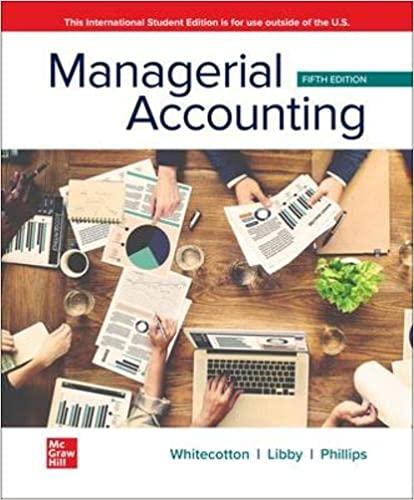Question
Draper, Inc. is a privately held furniture manufacturer. For August 2017, Draper had the following standards for one of its products, a wicker chair: Direct
Draper, Inc. is a privately held furniture manufacturer. For August 2017, Draper had the following standards for one of its products, a wicker chair:
Direct materials 2 square yards of input at $5.10 per square yard
Direct manufacturing labor 0.5 hours of input at $10.00 per hour
The following data were compiled regarding actual performance: actual output units (chairs) produced, 2,100; square yards of input purchased and used, 3,900; the price per square yard, $5.30; direct manufacturing labor costs, $9,310; actual hours of input, 950; labor price per hour, $9.80.
Requirement 1. Show computations of price and efficiency variances for direct materials and direct manufacturing labor. Give a plausible explanation of why each variance occurred.
Let's begin by determining the formula used to calculate the actual costs of direct materials, then enter the amounts in the formula and calculate the cost.
| Actual price | x | Actual input | = | Actual cost | |
| Direct materials | x | = |
Next, we will calculate the actual input at the budgeted price.
| Actual input | x | Budgeted price | = | Cost | |
| Direct materials | x | = | |||
| Direct manufacturing labor | x | = |
Determine the formula and calculate the costs for the flexible budget.
| Budgeted input for actual output | x | Budgeted price | = | Flexible budget cost | |
| Direct materials | x | = | |||
| Direct manufacturing labor | x | = |
Now compute the price and efficiency variances for direct materials and direct manufacturing labor. Label each variance as favorable (F) or unfavorable (U).
| Price | Efficiency | |||
| variances | variances | |||
| Direct materials | ||||
| Direct manufacturing labor | ||||
Requirement 2. Suppose 6,400 square yards of materials were purchased (at $5.30 per square yard), even though only 3,900 square yards were used. Suppose further that variances are identified at their most timely control point; accordingly, direct materials price variances are isolated and traced at the time of purchase to the purchasing department rather than to the production department. Compute the price and efficiency variances under this approach.
Begin with recalculating the costs using the information provided for the alternative approach.
| Actual Cost | Budgeted price | Flexible budget cost | |
| Purchasing | $ | $ | |
| Production | $ | $ |
Now compute the Direct materials price and efficiency variances. Label Favorable (F) or Unfavorable (U).
| Price variance | Efficiency variance | |||
| Direct materials | $ | U | $ | F |
Step by Step Solution
There are 3 Steps involved in it
Step: 1

Get Instant Access to Expert-Tailored Solutions
See step-by-step solutions with expert insights and AI powered tools for academic success
Step: 2

Step: 3

Ace Your Homework with AI
Get the answers you need in no time with our AI-driven, step-by-step assistance
Get Started


